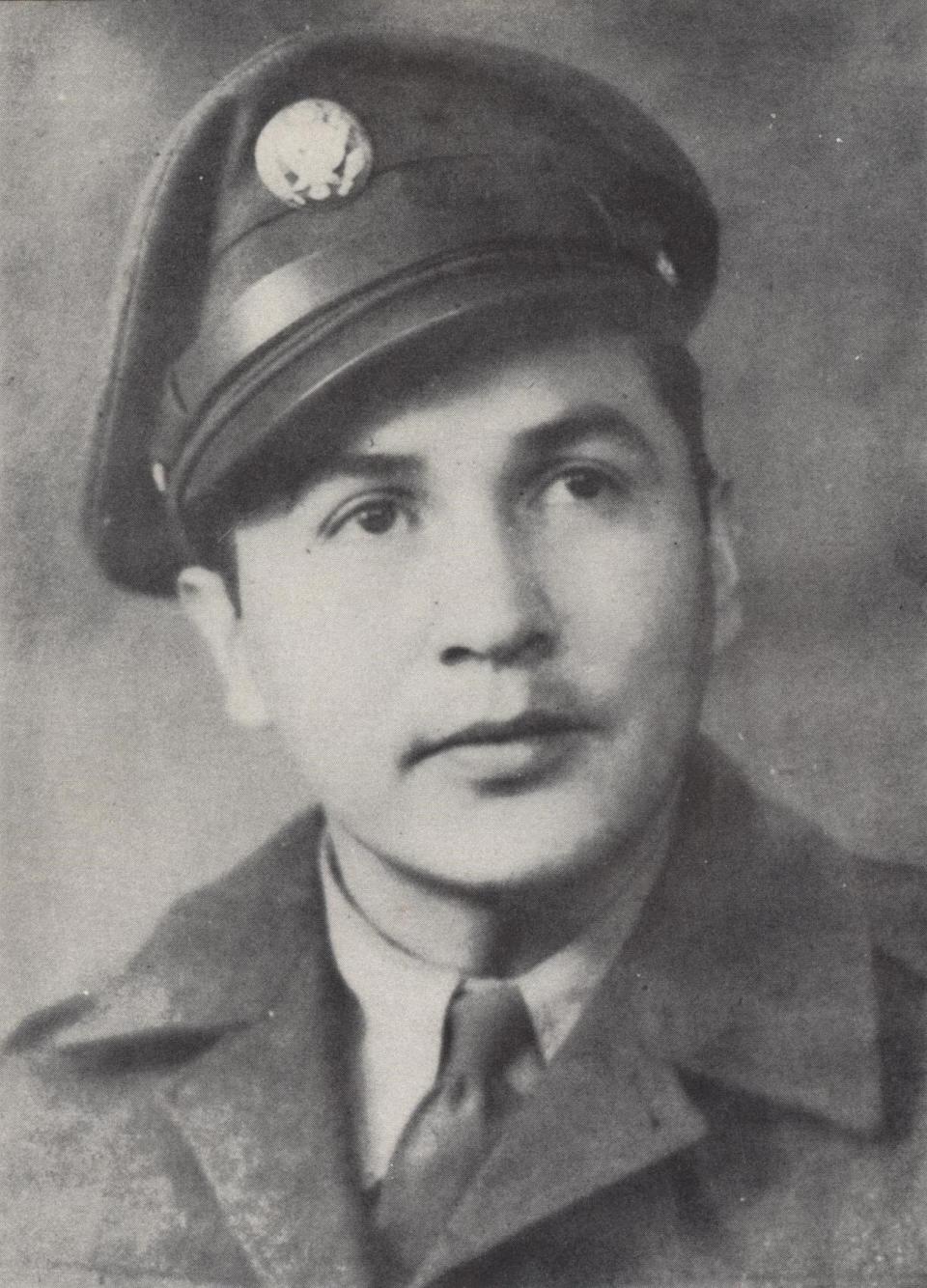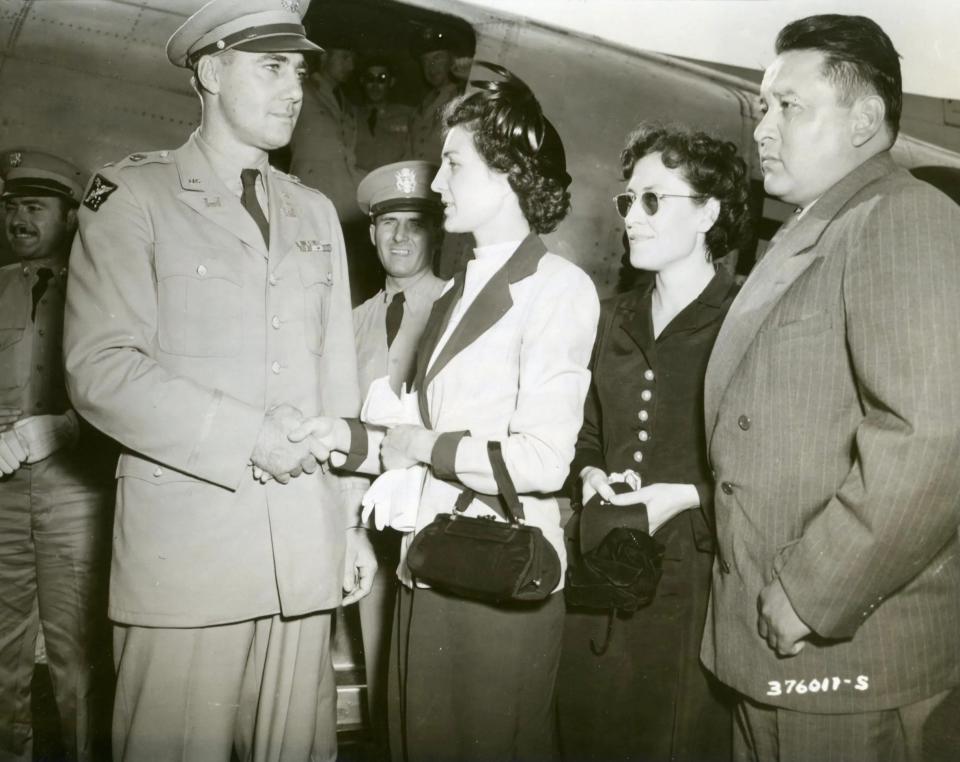Iowa History Month: How a Native American soldier’s funeral revealed Iowa’s racism
- Oops!Something went wrong.Please try again later.
On December 16, 1941, nine days after the attack on Pearl Harbor, the Sioux City Journal carried an article titled “Recruits Rush Stations Here.” Among the enlistees seeking to serve in the U.S. Army were two Winnebago men, Edward J. Snowball and John Raymond Rice from the town of Winnebago on the Nebraska side of the Missouri River.
Meskwaki men served, too. Edward Benson, Dewey Roberts, Frank Sanache, Willard Sanache, Melvin Twin, Judy Wayne Wabaunasee, Mike Wayne Wabaunasee and Dewey Youngbear worked as “Code Talkers” in the 168th Infantry. Overall, Native Americans had the war’s highest rate of voluntary enlistments, with about 45,000 of the eligible 350,000 Native Americans enlisted in the armed forces.
Meskwaki and other Native Americans had previously fought for the United States. Thomas Chuck, Bill Jones and Jonas Poweshiek were among those from Tama County who served in the Great War. This dedication was rewarded with increased rights for people of Tribal Nations when the Snyder Act of 1924 admitted them to full citizenship.
In 1869, the 15th Amendment to the U.S. Constitution provided that the right to vote could not be denied or abridged “on account of race, color, or previous condition of servitude,” but it wasn't until the Snyder Act that Native Americans received this right. Iowa newspapers reported that Republicans and Democrats courted the Meskwaki vote in that fall’s presidential election. The Davenport Daily Times of Nov. 20, 1942, noted the Meskwaki “thoroughly appreciate the newly earned right of suffrage.”
In spite of their civic engagement and military service, Native Americans continued to face discrimination in Iowa. Among the greatest indignities was that placed on the aforementioned John Raymond Rice. He served in the Pacific theater during World War II, and married Siouxland resident Evelyn Wilcox on Feb. 15, 1945, in Dakota City, Nebraska, while on furlough.

John survived the war and earned multiple honors, including four battle stars, the Philippine liberation medal and a presidential citation. Evelyn had already given birth to their daughter, Pamela Rae, in early 1946 when John reenlisted in the army due to limited employment opportunities for Native Americans.
He served stateside and in Korea prior to the U.S. entry in the Korean War, on June 25, 1950. A few weeks later, John Rice returned to combat duty in the Pusan Perimeter in the southeastern Korean peninsula. The divisions there took heavy casualties, and John Rice was killed in service on Sept. 6, 1950.
It took nearly a year for Rice’s body to be returned to the United States. Evelyn Rice made arrangements with salesman Ben Willey of Sioux City’s private Memorial Park Cemetery for an Aug. 28, 1951, burial. Services proceeded normally, including the playing of taps and a rifle salute until Willey noticed Winnebago veterans present. The cemetery had contractual covenants that limited burials to whites only. Willey prevented Rice's casket from being lowered into the ground, and it hung over the grave for about five hours. The casket with Rice’s remains was then returned to a funeral home in South Sioux City. Funeral home officials notified Evelyn of this affront.
In addition to the anger and trauma experienced by Evelyn and her family, veterans’ groups, civil rights advocates and government officials expressed outrage. President Harry S. Truman learned of the incident the following day and shared his anger. He proposed a burial in Arlington Cemetery with expenses paid by the federal government. Local officials scrambled to smooth over their bigoted behavior but stumbled. They attempted to get Evelyn to claim Rice was white as he had ancestry from Tribal Nations and Europeans. She refused, and accepted Truman’s offer.

A contingent from the Nebraska Highway Patrol escorted Rice’s body to the Iowa line on Sept. 2. An estimated crowd of 1,000 people turned out to honor him as the casket proceeded to Sioux City’s Milwaukee Road train station. He was buried in Arlington National Cemetery on Sept. 5 with Evelyn, his mother and other family members present.
Evelyn took action against the bigotry. She sued the Memorial Park Cemetery and its officials for $180,000. Iowa courts ruled against her twice, once in July 1952 in district court and at the Iowa Supreme Court in September 1953. The basis of the judgment was a narrow view of the 1884 Iowa Civil Rights Act. That law addressed equal treatment only in restaurants, hotels and places of amusement. Iowa courts maintained a limited scope of the statute, and allowed discrimination against citizens in many cases. She appealed to the U.S. Supreme Court, and lost in a 4-4 decision in November 1954.
Evelyn did not waver in her dedication, nor did she harbor ill will to the community of Sioux City. She submitted a letter to the city council saying she did not blame Siouxland residents for the bigoted treatment. She remained in the region until her death in 2005, and was interred in a place of honor next to her husband at Arlington National Cemetery.
Leo Landis is the state curator for the State Historical Society of Iowa, which provided this essay as part of a series for Iowa History Month. For more information, visit history.iowa.gov. He is indebted to Matt Anderson, curator of history at Sioux City Public Museum, who provided assistance with this essay.
March is Iowa History Month
To celebrate Iowa History Month, the Register has published weekly essays from leading state historians.
This article originally appeared on Des Moines Register: Iowa History Month: John Raymond Rice's funeral exposed racism in Iowa

